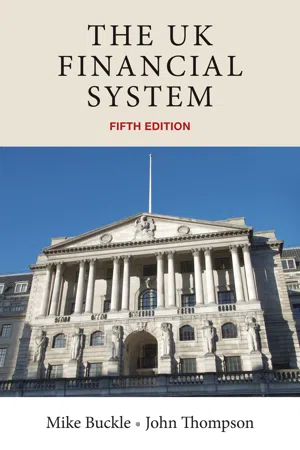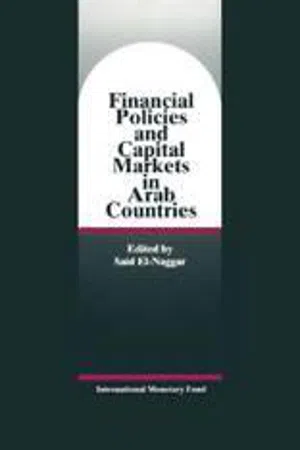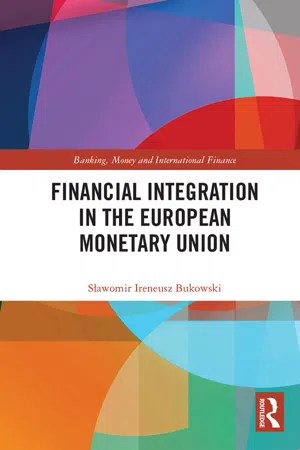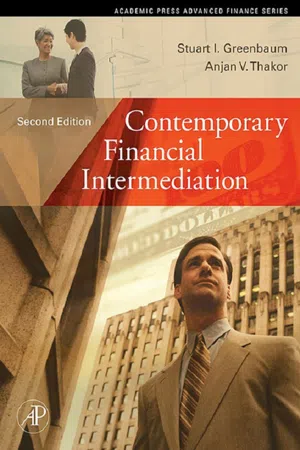Economics
Investment Intermediaries
Investment intermediaries are financial institutions that facilitate the flow of funds between investors and companies or governments in need of capital. They include entities such as banks, mutual funds, and brokerage firms. These intermediaries play a crucial role in connecting savers and borrowers, providing liquidity, and managing risk in the financial markets.
Written by Perlego with AI-assistance
Related key terms
5 Key excerpts on "Investment Intermediaries"
- eBook - ePub
The UK financial system
Theory and practice, fifth edition
- Mike Buckle, John Thompson(Authors)
- 2016(Publication Date)
- Manchester University Press(Publisher)
Part IInstitutionsPassage contains an image
Chapter 2Financial intermediation and recent developments in the UK financial system
2.1 IntroductionWe saw in chapter 1 that financial intermediation is one of the key functions of a financial system, connecting savers and borrowers and directing funds towards productive investments. In this chapter our primary aim is to describe the process of financial intermediation and in doing so we examine the arguments as to why we need financial institutions such as banks. Finally, we provide an overview of the tremendous changes that have taken place in the UK financial system over the last 20 years. This will provide a framework for the more specific discussion of events affecting financial institutions and markets which make up the remainder of this book.2.2 The nature of financial intermediationIn developed economies, decisions to invest (in capital projects) are often taken separately from decisions to save. There are some exceptions to this: for example, firms which do not distribute all profits as dividends but retain some to finance investment are both saving and investing. However, even when saving and investment are carried out by the same economic agent, the timing of the decisions will often be different. Saving may precede the investment as sufficient funds are accumulated, or the saving may follow the investment as debts used to finance it are paid off. However, it is a general feature of developed economies that a high proportion of saving is not used immediately by the saver but is made available to investors elsewhere. In chapter 1 - eBook - ePub
Financial Systems
Principles and Organization
- Edwin H. Neave(Author)
- 2002(Publication Date)
- Routledge(Publisher)
Mutual funds pursue a variety of goals. Some emphasise growth stocks, others mixed portfolios of bonds and stocks, still others just bonds. The principal service provided by any investment fund is to form a diversified portfolio at lower costs than can individual investors. However, many studies of investment companies show that their portfolios usually earn a return, after adjusting for administration expenses, no greater than that on a comparable market index portfolio. Nevertheless, investors are attracted to the funds whenever they offer the prospect of relatively lucrative returns. For example, in the late 1980s and early 1990s sales of mutual funds were exceptionally large. While new sales fell off and redemptions increased around 1993 or so, subsequently new sales have again strengthened and investment companies are an increasingly popular vehicle for household savings. In the US, investment companies are federally regulated under legislation similar to, but less stringent than, that governing pension funds.16.7 INSURANCE COMPANIES
Insurance companies are financial intermediaries because they collect premiums that remain invested until paid out in claims or transferred to earnings. Life insurance companies insure against policyholder death or loss of income, while property and casualty insurance companies against such events as fire or hurricane damage to a building. Insurance companies strive to profit from the premiums they charge for underwriting (assuming) risks. In effect, an insurance company writes put options on assets possessed by the insured parties, and sells these puts, in a form called insurance policies, to policyholders. The premiums it collects from policyholders are the prices at which it sells the puts. Most insurance policies are written for one year or more, and are arranged by individual negotiation with the party purchasing the insurance. Life insurance, fire insurance and mortgage principal insurance are all well-known examples.Some insurance companies establish regional underwriting limits in an attempt to diversify risks geographically. If the regional constraints are smaller than the demand for insurance in a particular period, the intermediaries are able to write policies only until the allocation is exhausted. Such constraints create financial market imperfections similar to legislation placing geographical lending restrictions on mortgage lenders. It is not clear why the insurance companies use underwriting limits instead of charging higher premiums in regions with particularly buoyant insurance demand, unless they perceive political or public relations difficulties to implementing rate policies of this sort. - Saíd El-Naggar(Author)
- 1994(Publication Date)
- INTERNATIONAL MONETARY FUND(Publisher)
The supply of equities in many countries has been limited by the reluctance of owners of private companies to dilute their ownership and control by issuing stock to the public and to comply with requirements to disclose information about their operations. The availability of less expensive debt finance has also discouraged equity issues. The absence of an appropriate legal, regulatory and tax framework has further inhibited the development of capital markets. Double taxation on dividends and capital gains, and the tax-free status of government securities has lessened the appeal of private equity and bonds. Investor confidence has been further undermined by the lax enforcement of corporate income taxes as closely held corporations are able to avoid taxes by showing depressed profits. The lack of timely and accurate financial information has often resulted in speculative trading that has further hurt investor demand for securities in developing countries.The efficient functioning of financial markets also depends on institutions that lend and borrow little on their own account; investment banks, securities brokers and credit rating agencies.Investment Banks . Investment banks are important constituents of securities markets; they are intermediaries for locating and collecting funds for their clients so they can finance new investment products. They are major players in the development of securities offerings. In addition, they arrange private placements, provide funds management, and perform corporate advisory and portfolio management services. Investment banks have yet to play a major role in Arab countries, which are still in the process of developing their nascent capital markets.Investment bankers bring new securities to the market by purchasing whole issues of securities from corporate issuers or from public bodies and distributing them to institutional and individual investors. By making a firm commitment to purchase the securities from the company, the investment banker insures any risk associated with a new issue. This service, known as underwriting, permits government and corporate entities to broaden their sources of long-term financing beyond the banking system. Underwriting is critical to the development of emerging markets where corporate or public entities are reluctant to raise equity capital without the guarantee provided by this service. Investment banks are also market makers in secondary markets.Corporate advisory services are a growing business for investment banks in emerging markets. The private sector in many developing countries has been accustomed to functioning in heavily controlled and protected market environments that have provided inadequate preparation for businesses to respond to market signals. Investment banks can play an important part in advising businesses on how to compete in a more open and international economy. However, they also have a key advisory role in relation to project financing, i.e., identifying project risks, attracting technical partners, identifying and selecting sources of finance, and structuring the financial package. While banks, long-term financing institutions, and institutional investors provide financing, investment banks arrange financing and can play a useful role in organizing loan syndications for large amounts of financing.- S?awomir Ireneusz Bukowski(Author)
- 2019(Publication Date)
- Routledge(Publisher)
B. Scholtens and D. van Wensveen (2003, pp. 35–37) point to an essential characteristic of financial intermediation, namely creating added value for savers and investors comprised in financial instruments. This type of instrument cannot be created together or individually by savers and investors. This process of added value creation is intensified by competition between the existing financial institutions and those entering the market and introducing financial innovations. Financial institutions must continuously analyze the preferences of the financial market participants and translate these preferences into characteristics of new financial products. An important function of financial intermediation institutions is risk transformation. They create added value by creating financial instruments that absorb risk. In this way, the sector of financial intermediation institutions has evolved into the financial industry sector (see also Allen & Santomero, 1997, pp. 1461–1476; Merton & Bodie, 1995, pp. 1–27; Allen & Gale, 2001, pp. 127–149).As it was mentioned before, the relationship between the role and place in the market of financial intermediation institutions (banks, insurance societies, investment funds, etc.) and the market of financial instruments has changed. In the traditional system, direct customers of financial intermediaries – savings providers and borrowers – were households of lower income and assets and small and medium-size enterprises (SMEs).In the modern system formed as a result of the just-described phenomena related to knowledge-based economy, households and SMEs are customers of financial intermediation institutions that intermediate in investing resources obtained from them in the market of financial instruments (especially those listed in organized markets) and offering products based on exchange listed financial instruments. On the other hand, big companies benefit, to a large extent, from raising financial resources directly in organized capital markets (exchanges).It is a result of the just-described factors that financial intermediation institutions have become financial product providers creating added value. At the same time, such a state of affairs indicates the growing role of financial markets in economy and even the fact that they have become “the heart” of the financial system and market economy and the money and information “pump.”- eBook - ePub
- Stuart I. Greenbaum, Anjan V. Thakor(Authors)
- 2007(Publication Date)
- Academic Press(Publisher)
Glass-Steagall created two banking systems. Commercial bankers had subsidized deposits, but restricted asset choice. The investment banks were without deposit subsidies, but had great freedom on the asset side of the balance sheet, and protection from commercial bank competition in equity markets. This permitted the investment bankers to selectively attack the commercial banks’ niches of profitability, forcing them into ever riskier endeavors in order to justify the capital committed to commercial banking. The intricate and exquisitely contradictory relationship between commercial banks and investment banks is a product of American history. Their functions are substantially overlapping. The forms and instruments employed often differ only at a superficial level. Moreover, the investment banks are as much a creation of 1930s banking legislation as the commercial banks. With the dismantling of the Glass-Steagall Act and the passage of the Gramm-Leach-Bliley Act, this artificial separation between commercial and investment banking has been finally eliminated.The Role of the Government
To this point, we have sketched the major players in the world of financial intermediation. Probably the most important intermediaries to add to this list are the vast government enterprises that routinely provide a wide variety of financial services. These would include the Old Age, Survivors and Disability Insurance, Workers’ Compensation, Medicare, the housing agencies (Federal National Mortgage Corporations of FNMA or “Fannie Mae,” Federal Home Loan Mortgage Corporation or FHLMC or “Freddie Mac,” and the Government National Mortgage Association or GNMA or “Ginnie Mae”) Farm Credit Administration, Small Business Administration, Student Loan Marketing Association (or “Sally Mae”), and flood insurance programs of the Agriculture Department. And the list goes on!Annual payments to the federal government’s Old Age, Survivors, Disability Insurance, and Medicare programs are twice the assets of the largest commercial bank in the United States, and about one-sixth the assets of the entire commercial banking industry. Without doubt, the U.S. government is far and away the largest financial services provider in the country and arguably in the world.Financial Intermediaries on the Periphery
Gambling
Prominent on the periphery of the financial intermediation universe is the glamorous world of legal and illegal gambling. Some deny that gambling is a financial service, but this seems a quibble. The bookmaker is as much a broker as the trader of options and financial futures. The naysayers argue that gambling creates
Learn about this page
Index pages curate the most relevant extracts from our library of academic textbooks. They’ve been created using an in-house natural language model (NLM), each adding context and meaning to key research topics.




